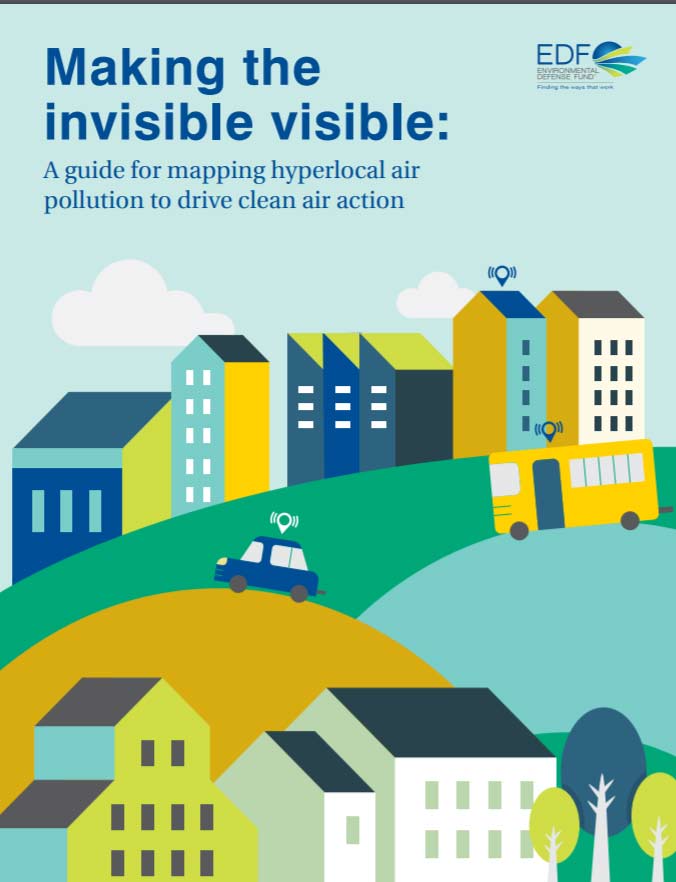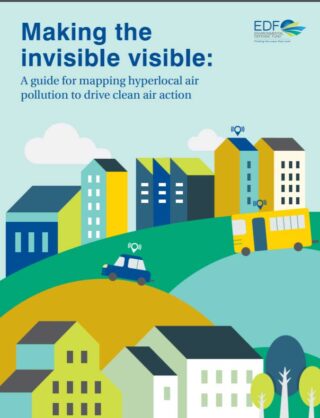- Resources
- Here’s how cities, communities and businesses can work together to clean our air
Resources
Here’s how cities, communities and businesses can work together to clean our air
Published: October 8, 2019 by Harold Rickenbacker
It’s true that in many cities, air quality is better now than it was decades ago. But urban air quality is still a health risk in far too many places. Premature death from air pollution is about 50 percent more common in cities than in rural areas. On days with higher air pollution, stock returns are lower, and students perform worse on exams. Companies in highly polluted cities have to offer a form of “hazard pay.” And with about 1.5 million people relocating to urban centers every week, air quality will remain a persistent and urgent problem for city leaders around the world.

EDF has been working for over three years to demonstrate how hyperlocal air quality monitoring can help local officials better identify and address dirty air. This week, at the 2019 C40 World Mayors Summit in Copenhagen, we released a guide that captures our experiences from groundbreaking monitoring pilots, and the lessons we learned along the way: Making the Invisible Visible: A guide for mapping hyperlocal air pollution to drive clean air action.
Air monitoring technology has been around for a long time. Many cities use some sort of monitoring technology either by choice or by mandate. But most systems are limited, either by spatial coverage or temporal resolution. Or both. They can offer broad, regional insights, but often cannot pinpoint specific pollution sources, highlight key trouble spots or show how air quality changes over time.
New advancements in hyperlocal sensors are changing that, allowing incredibly detailed insights about specific facilities, roads or neighborhoods and how air quality may change at those locations over the course of a day, week or year. We can now pinpoint hotspots, examine their causes, and develop solutions tailored to each city – or, in some cases, each intersection.
“Block-by-block data is critical to have as we work to improve health in our most vulnerable communities,” said Elena Craft, Ph.D., senior director for climate and health at EDF and a co-author of the guide. “We show cities how to design, analyze, and leverage data from hyperlocal air quality monitoring networks to identify air pollution problems and implement emergency public health interventions to mitigate its risk.”
Considering the measurement and data gaps from regulatory monitoring sites, hyperlocal monitoring is lauded as a new technique providing a more holistic picture of air quality trends at higher spatial and temporal resolution. Hyperlocal insights paired with regulatory data has spurred unprecedented networks of sensors that empower communities, researchers and policymakers and help move from data to action.

Given the potential of these new insights, “new sensors and analytics are an emerging business opportunity for technology developers,” noted Aileen Nowlan, senior manager at EDF+Business and a guide co-author. “As stakeholders learn how business activities like fossil-fuel based transportation contribute to air pollution where they live, work, and play, business leaders are being called on to create two-for-one impact, targeting solutions at climate and health.”
The potential is exciting. But figuring out how to design, deploy or develop policy from these systems can be daunting for local officials or community leaders. That’s where our new guide — based on our work in Houston, Oakland, and London – is intended to help. Whether a city is just now considering hyperlocal air quality monitoring, or already has one in place and is trying to turn its data into solutions, the guide meets people where they are.
We cover the three core stages:
- Getting Started, which examines specific air quality challenges and research tools and introduces how new insights can enable a suite of targeted solutions focused on investigations, emergency response, transportation and traffic, land use, and investments and incentives;
- Nuts & Bolts, which provides detailed steps for designing a hyperlocal monitoring network, implementing the network, and analyzing the data; and
- Data to Action, which outlines how to evaluate various air quality solutions, build community awareness, and measure progress of policy decision.
EDF was the first nonprofit and international organization to work closely with cities and community-based organizations to pilot mobile monitoring campaigns as a compliment to existing regulatory air pollution networks. Local leaders and organizations, in fact, are key to the success of these kinds of systems.
“Frontline communities bear the brunt of the impact of air pollution,” said Fern Uennatornwaranggoon, manager of air quality policy at EDF and a co-author of the guide. “Their involvement in developing monitoring campaigns isn’t just helpful, it’s critical. And they should be a cornerstone of any local hyperlocal air quality monitoring effort.”
We’re excited about the potential of this emerging capability. We think it will help local leaders more effectively identify and solve their most persistent air quality challenges. And for the millions of people that move into cities every week, that’s some news that they can breathe easy about.
